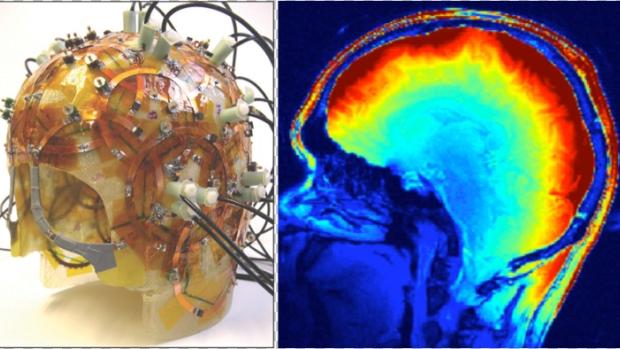National Academy of Engineering Selects Young MRI Researcher for Prestigious Frontiers of Engineering Symposium
NYU’S Riccardo Lattanzi Probes How MRI Interacts with Human Tissue with an Eye to Improving Diagnosis

Riccardo Lattanzi is trying to improve diagnoses by understanding and exploiting the interaction of electromagnetic fields with tissues in MRI. At left is a 32-channel MRI coil prototype developed by his research group to detect magnetic fields. The illustration at right shows the measured distribution of the magnetic field in the brain tissue.
BROOKLYN, New York – Riccardo Lattanzi will participate in the National Academy of Engineering’s E.U.-U.S. Frontiers of Engineering Symposium, an invitation-only gathering of 60 early-career scientists designed to promote interdisciplinary research collaborations. Lattanzi’s research probes the interaction between the radio frequency electromagnetic fields used in magnetic resonance imaging (MRI) and human tissue. He is developing novel noninvasive methods to map the electrical conductivity and permittivity of various tissue types — information that could maximize the diagnostic benefits of MRI.
Lattanzi is an associate professor of electrical and computer engineering at the NYU Tandon School of Engineering and radiology at the NYU School of Medicine. He is also a member of NYU WIRELESS, a multidisciplinary research center focused on developing next-generation wireless technologies.

Lattanzi explained that predicting how and where radiofrequency energy is absorbed and dissipated in the body is a challenge that hampers efforts to improve the sensitivity of modern MRI scanners. “We have to keep these machines on a leash because we are still unable to control their full power,” Lattanzi said, noting that for safety reasons, ultra-high field MRI scanners often operate at power levels below their capacity due to this knowledge gap.
Measuring the electrical properties of tissues would enable MRI engineers to monitor and control radiofrequency energy deposition. In addition, these measurements could also reveal local changes in conductivity that may serve as biomarkers for cancer and other pathologies, and could help improve the accuracy of medical procedures including radio frequency ablation, a technique used to target malignant cells.
During the two-day Frontiers of Engineering conference, which takes place November 16-18 at the University of California, Davis, Lattanzi and his fellow symposium participants will attend poster presentations and discussion sections in four areas: space exploration, next-generation solar cells, neuroengineering, and computational imaging. Lattanzi’s presentation is entitled, "Interaction between Radiofrequency Fields and Biological Tissue in Magnetic Resonance: Challenges and Opportunities.”
In 2015, Lattanzi received the prestigious Faculty Early Career Development Award — also known as the CAREER Award — from the National Science Foundation. He is also the recipient of the I.I. Rabi Young Investigator Award from the International Society for Magnetic Resonance in Medicine.
Note: Images available at http://dam.engineering.nyu.edu/?c=2004&k=53703179e5
About the New York University Tandon School of Engineering
The NYU Tandon School of Engineering dates to 1854, the founding date for both the New York University School of Civil Engineering and Architecture and the Brooklyn Collegiate and Polytechnic Institute (widely known as Brooklyn Poly). A January 2014 merger created a comprehensive school of education and research in engineering and applied sciences, rooted in a tradition of invention and entrepreneurship and dedicated to furthering technology in service to society. In addition to its main location in Brooklyn, NYU Tandon collaborates with other schools within NYU, the country’s largest private research university, and is closely connected to engineering programs at NYU Abu Dhabi and NYU Shanghai. It operates Future Labs focused on start-up businesses in downtown Manhattan and Brooklyn and an award-winning online graduate program. For more information, visit engineering.nyu.edu.

